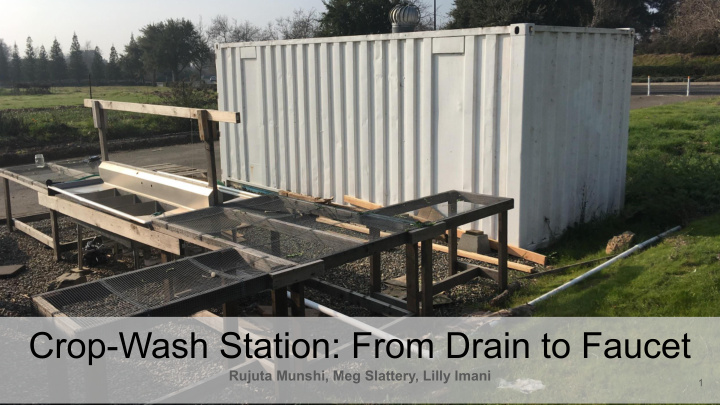



Crop-Wash Station: From Drain to Faucet Rujuta Munshi, Meg Slattery, Lilly Imani 1
Our Team 2
Final Project Statement Evaluate alternative methods to recycle water from a crop wash station while promoting food safety at the New Roots farm in West Sacramento. 3
❖ ❖ ❖ ❖ ❖ 4
❖ Site Visits ❖ Sector Papers ➢ Food safety ➢ Sediment Removal ➢ UV Purification ❖ Water quality testing ❖ Prior Art 5
Current Practice Water Capture Sediment Removal Sink and Spray Water Disposal Filtration vs. Gravity Settling UV Purification Irrigation ➢ Watering Schedule Power ➢ Land ➢ Low Turbidity (<18 NTU) ➢ ➢ Irrigation Water Standard Drinking Water Standard ➢ 6
Bag Filters → Activated Carbon Filters → Electrocoagulation → UV Disinfection → Drip Irrigation Recycled Wash Water Greenhouse Water Reuse 1 Lettuce Wash Water Treatment 2 7
Water Quality Testing Coliform E. Coli First Spray Hose Water Hose Water First Spray Outlet Outlet Final Spray Final Spray 8
Design Criteria 9
Potential solutions 2 3 5 4 10
Pressurized Low/Medium Low Water Sediment Level Sediment Level (15-25Psi) Sink Water Pressure Filtration Water Capture Water Storage increase Sand/Biochar/Gravel (Solar) Water Pump Container PVC piping Meets drinking water std. 0 coliform 0 e.coli Discharge Hand Wash UV filter Greywater Station (Solar) power Open land Water Storage Reservoir Needs 3 ft pressure head Gravel Chlorination Biodegradable Soap
Strengths Weaknesses Incorporates UV filter High filtration required 18 NTU is an easy to reach turbidity Requires solar pumps level Requires biodegradable products Repurposes greywater Opportunities Threats Develop a curriculum based on Maintenance is critical to system waterborne bacteria and its impact on health Human health risk if not used properly (unchlorinated water is Can provide improved sanitation accidentally ingested)
Results: Decision Matrix Ease of Cost to Learning Value Ease of Option Safety Total use Implement Opportunity added installation Dispose 75 5 5 5 3 5 4 0 3 0 3 5 3 directly* 68 Crop wash 3 5 3 3 2 4 5 3 5 3 2 3 Drip 64 4 5 3 3 2 4 3 3 5 3 1 3 Irrigation* Furrow 74 4 5 3 3 3 4 4 3 4 3 3 3 Irrigation* Rain 83 5 5 5 3 4 4 3 3 2 3 4 3 garden* 72 Hand wash 3 5 3 3 3 4 5 3 4 3 3 3 13 *Does not use UV purifier
● Work with client to determine final design and follow information on the flow charts to prototype a solution. ● Incorporate food safety curriculum. 14
Questions? 15
More recommend